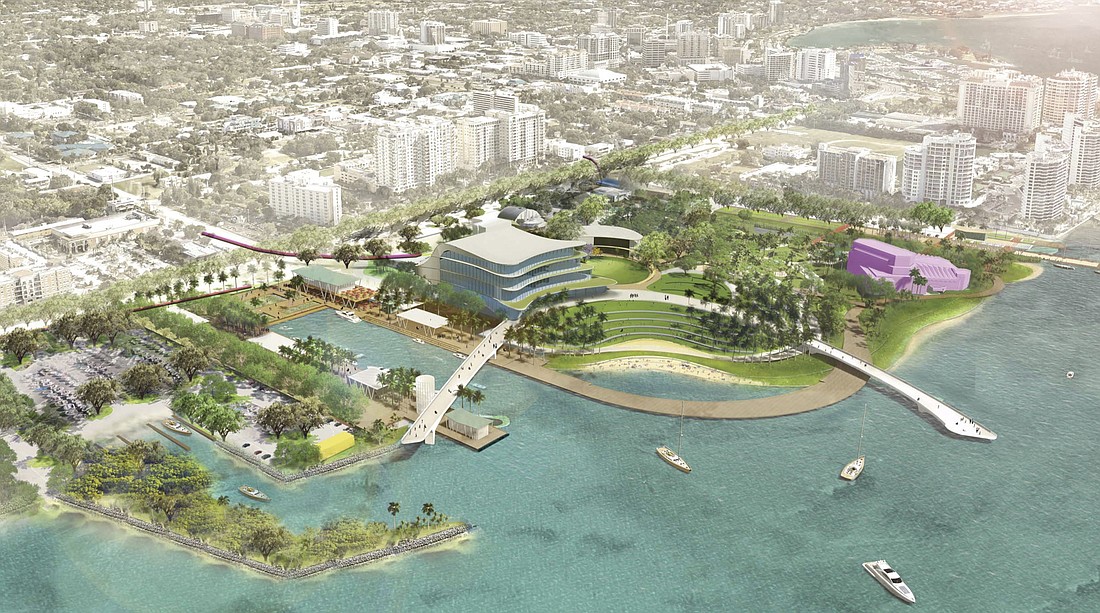- December 20, 2025
-
-
Loading

Loading

On Monday, Bill Waddill met with the City Commission to discuss a proposed funding mechanism for the redevelopment of the bayfront land surrounding the Van Wezel Performing Arts Hall.
Waddill is chief implementation officer for The Bay Park Conservancy, a private group formed to lead the construction of a public park on 53 acres of city-owned land. The Bay hopes to set up a tax-increment financing district to help pay for the project, expected to cost between $100 million and $200 million.
Tax-increment financing is a tool that captures increases in property tax value within a certain area. The Bay envisioned drawing a district around the bayfront site, funneling property taxes from the immediate area into the project.
The City Commission, however, may have a broader vision for that money. During Monday’s meeting, board members suggested TIF funds could be used for a variety of purposes: improving parks in other areas of the city, enhancing connectivity to the bayfront site and supporting other city priorities such as workforce training and affordable housing.
“This is our opportunity to create more than just the 53 acres and the park, and to create a community for all,” Commissioner Willie Shaw said.
Although Waddill said The Bay is open to conversations about how to structure a TIF district, the City Commission’s perspective may complicate the process of establishing a financing agreement. The board agreed to send a letter on behalf of the city to county officials asking to begin a collaborative discussion about funding the bayfront project. Already, however, the county has indicated it has a different perspective on what a TIF district should look like.
City commissioners said they’d like to consider expanding the boundaries of the TIF district and using the money for a variety of purposes. County officials, by contrast, have said they want a narrowly defined TIF district with money primarily going toward capital improvements on the bayfront site.
At Monday’s meeting, city staff members made explicit the potential challenges the commission’s discussion presented.
“We risk the county not wanting to participate if we do some other things,” Assistant City Manager John Lege said.
In March, the County Commission shared some concerns regarding the prospect of financially supporting the bayfront project. Board members expressed hesitancy about entering a long-term agreement or offering money before other funding had been lined up. The group said it didn’t want to see a convoluted funding arrangement or one in danger of fizzling out for lack of support.
“You all really have to make this easy for this County Commission or future county commissions to say ‘we’re in,’ ” County Commissioner Charles Hines said.
Despite both governments staking out different opening positions, Waddill was optimistic about the prospect of striking a deal that worked for both sides. He said The Bay envisioned capturing about $100 million to help pay for the park project and the construction of a new performing arts center to replace the Van Wezel.
City Commissioner Jen Ahearn-Koch expressed some concern about restricting the city’s ability to spend rising property tax revenue from the area around the bayfront.
“This is an area of growth, big growth in the future,” Ahearn-Koch said. “These are dollars that are not going to be spent citywide. They’re just going to be in this district.”
Waddill said the negotiations with city and county staff would help define the parameters of any TIF proposal. Variables that will be discussed include the length of the agreement, the boundaries of the district and the percentage of tax increments that will be redirected from the city and county’s general funds toward the bayfront. Waddill said initial projections indicate The Bay would not need to use the entirety of the tax increment to pay for the project.
“I think there’s more than enough revenue there,” Waddill said.